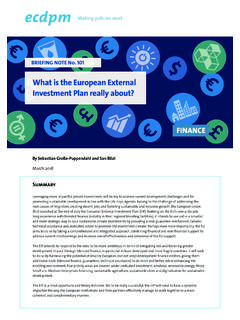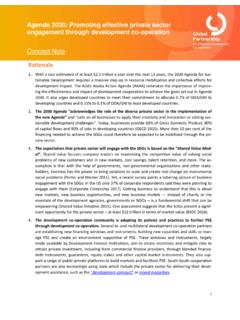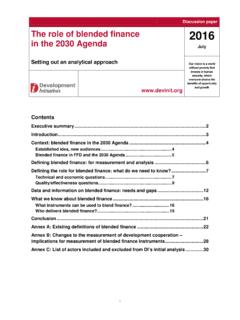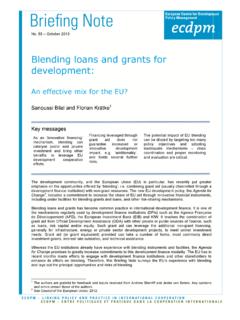Transcription of DC Financing for Development 4-1-2015FINAL
1 Development COMMITTEE (Joint Ministerial Committee of the Boards of Governors of the Bank and the Fund on the Transfer of Real Resources to Developing Countries) DC2015-0002 April 2, 2015 FROM billions to trillions : TRANSFORMING Development finance POST-2015 Financing FOR Development : MULTILATERAL Development finance Attached is a document entitled From billions to trillions : Transforming Development finance Post-2015 Financing for Development : Multilateral Development finance prepared jointly by the African Development Bank, the Asian Development Bank, the European Bank for Reconstruction and Development , the European Investment Bank, the Inter-American Development Bank, the International Monetary Fund, and the World Bank Group for the April 18, 2015 Development Committee meeting. * * * From billions to trillions : Transforming Development finance Post-2015 Financing for Development : Multilateral Development finance Development Committee Discussion Note Prepared jointly by African Development Bank Asian Development Bank European Bank for Reconstruction and Development European Investment Bank Inter-American Development Bank International Monetary Fund and World Bank Group i Abbreviations and Acronyms BEPS Base Erosion and Profit Shifting BRICS Brazil, Russia, India.
2 China and South Africa CIT Corporate Income Tax COP21 21st Conference of the Parties DRM Domestic Resource Mobilization EOI Exchange of Information ESG Environmental Social and Governance FCS Fragile and Conflict States FDI Foreign Direct Investment GDP Gross Domestic Product GPGs Global Public Goods IMF International Monetary Fund LICs Low-Income Countries LMICs Lower Middle Income Countries MDBs Multilateral Development Banks MDGs Millennium Development Goals MICs Middle-Income Countries MSME Micro, Small and Medium-sized Enterprise ODA Official Development Assistance OECD Organization for Economic Co-operation and Development OOF Other Official Flows PIT Personal Income Tax PPP Public-Private Partnership RPGs Regional Public Goods SDGs Sustainable Development Goals UMICs Upper Middle Income Countries UN United Nations UNFCCC United Nations Framework Convention on Climate Change VAT Value-Added Tax WBG World Bank Group ii Table of Contents I.
3 Global Flow of Funds for II. Sources of Development A. Strengthening Domestic Resource Mobilization and Public 1. Domestic Resource Mobilization increasing available public 2. Public Expenditures improving quality and efficiency to increase Development 3. Subnational finance vital link to the 4. Policy Guidance and Technical Assistance expanding support to public resource mobilization and B. Engaging and Incentivizing Private 1. Enhancing project preparation and risk mitigation to catalyze investment 2. Promoting local capital markets and facilitating greater access to local currency 3. Supporting local banking and other domestic finance to expand 4. Enhancing the impact of the private sector via inclusion and 5. Providing new and expanded channels to enhance private sector flows and expertise towards C. International Public finance : Global Issues, Regional and Global Public 1. Climate Change and Implications for III.
4 Financing Solutions to Help Achieve the Looking 1 This Development Committee Discussion Note is the joint product of the African Development Bank, Asian Development Bank, European Bank for Reconstruction and Development , European Investment Bank, Inter-American Development Bank, International Monetary Fund, and World Bank Group. In this critical year for Development , we have come together to explore and confirm what we can do, within our respective institutional mandates, to support, and in particular finance , the eventual achievement of the proposed post-2015 Sustainable Development Goals (SDGs). We are financial institutions committed to eradicate poverty and inequality, able to leverage and catalyze public and private Development finance as well as to provide technical assistance, learning opportunities and policy advice to our clients. The Third International Conference on Financing for Development in Addis Ababa in July1 will be an important milestone in the post-2015 global effort to achieve universal and sustainable Development , underpinning the expected adoption of the SDGs at the UN Special Summit for Sustainable Development in New York in September.
5 This trajectory will continue with the World Bank Group International Monetary Fund Annual Meetings in Lima in October, and with the 21st Conference of the Parties (COP21) to the United Nations Framework Convention on Climate Change in Paris in December, which seeks a new international agreement on climate change. In short, 2015 will create a platform to support global Development aspirations for the next 15 years. This note proposes a preliminary vision for the collective role of our institutions looking toward the Addis Financing for Development Conference and beyond. Guidance is sought from Development Committee members, who include shareholders from each of our institutions, on how the Multilateral Development Banks (MDBs) and the International Monetary Fund (IMF) might best cooperate with respect to our individual and shared responsibilities and activities to support country clients in Financing the Sustainable Development Goals.
6 1 The Zero Draft of the Outcome Document for the Third International Conference on Financing for Development may be found at . From billions to trillions : Transforming Development finance To meet the investment needs of the Sustainable Development Goals, the global community needs to move the discussion from Billions in ODA to Trillions in investments of all kinds: public and private, national and global, in both capital and capacity. Globally, achieving the proposed SDGs will require the best possible use of each grant dollar, beginning with some US$ 135 billion in ODA. Yet flows for Development include philanthropy, remittances, South-South flows and other official assistance, and foreign direct investment together these sources amount to nearly US$ 1 trillion that needs to be used just as effectively. The most substantial Development spending happens at the national level in the form of public resources, while the largest potential is from private sector business, finance and investment.
7 This is the trajectory from billions to trillions , which each country and the global community must support together to finance and achieve the transformative vision of the SDGs. billions to trillions is shorthand for the realization that achieving the SDGs will require more than money. It needs a global change of mindsets, approaches and accountabilities to reflect and transform the new reality of a developing world with highly varied country contexts. 2 1. The proposed SDGs are ambitious. They aim to meet the dual challenge of overcoming poverty and protecting the planet. They will build on the experience acquired in pursuing the Millennium Development Goals (MDGs) and pick up the unfinished agenda,2 but they go further, highlighting a comprehensive vision of sustainable Development that embraces economic, social and environmental dimensions. The Financing resources needed to achieve the SDGs will surpass current Development financial flows.
8 2. More financial resources are available globally, but channeling them to support the SDGs will be a challenge. In principle, humanity has the resources to achieve the SDGs. Reflecting developments in the global economy over the last decade, large amounts of investable resources, mostly private, are available in advanced and emerging economies. In addition, domestic public resources, even in low-income countries, can be increased. However, not all available public and private resources will automatically be allocated and used effectively to support the SDGs. Nor are they programmable by or responsive to policy making bodies or conferences. 3. A paradigm shift on how Development will be financed is required to unlock the resources needed to achieve the SDGs. The world needs intelligent Development finance that goes well beyond filling Financing gaps and that can be used strategically to unlock, leverage, and catalyze private flows and domestic resources.
9 Official Development Assistance (ODA) will remain an important source of external public Financing . ODA levels can and should rise as developed countries increase assistance levels and all available grant funding is critical and should be used as effectively as possible. Yet ODA flows are only a small part of Development flows. In the future, ODA must be targeted increasingly to crowd in other funding sources: (i) for Low-Income Countries (LICs), on the basis of poverty, vulnerability, and limited fiscal capacity; and (ii) for Middle-Income Countries (MICs), by playing an increasing role to leverage and catalyze public and private sources of Financing . 4. To help generate the needed flows domestic public resources and private finance MDBs and the IMF have two primary functions: providing policy guidance, and Development finance and financial support to clients. The business models of the MDBs and the IMF reflect shared attributes including: 1) Financial leverage: The financial structure and Financing capabilities of the MDBs and the IMF enable them to leverage their capital to provide finance in many forms (from grants to blended concessional finance to loans to guarantees to equity investment) and purposes.
10 The non-concessional institutions/windows of the MDBs are funded efficiently by small amounts of paid-in capital, in many cases backed by callable capital. 3 Leveraging these amounts, the banking model of the MDBs mobilizes substantial resources from the capital markets at interest rates reflecting their strong financial structure and high ratings. In addition, grant and concessional funding from shareholders and other Development partners supports concessional Financing for the poorest, fragile and conflict-affected states. The MDBs received inflows from their shareholders of around US$ 38 billion in These flows allowed the MDBs to make public and private disbursements of US$ 99 billion in developing countries in 2013, and to approve new commitments for US$ 173 2 World Bank Group, Global Monitoring Report 2014/2015: Ending Poverty and Sharing Prosperity, 2015 3 The MDBs provide non-concessional financial assistance to MICs and some creditworthy LICs on market-based terms.



















